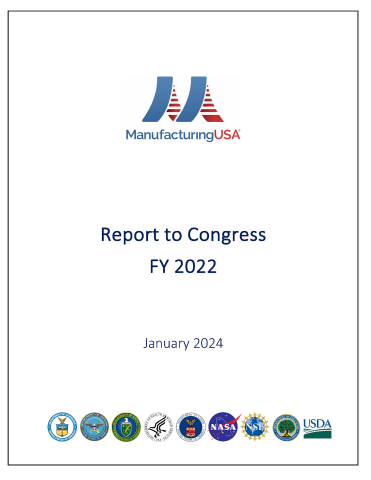This past year brought renewed collective focus on harnessing the power of technology to accelerate manufacturing and bolster economic and national security for communities and the nation. From once-in-a-generation legislation to bolster U.S. manufacturing via the CHIPS and Science Act1, the Bipartisan Infrastructure Law2, and the Inflation Reduction Act3, to increased leverage of public-private partnerships, Manufacturing USA is poised to deliver even more impact through advanced manufacturing technology, ecosystem growth, and workforce development efforts.

Through the Manufacturing USA® network, our agencies support a coalition of partners collaborating to secure U.S. global leadership in advanced manufacturing. Through large-scale technology, supply chain and ecosystem, and workforce development initiatives, we are helping ensure that what’s invented here is made here by a skilled American workforce. The manufacturing innovation institutes sponsored by our agencies and participating in the network serve as unique public-private partners helping make our vision a reality.
In 2022, the institutes worked with more than 2,500 member organizations on more than 670 applied research and development technology projects of high priority to industry. Manufacturers represent 63% of institute members, with nearly three-quarters of those being small and medium-sized. Continued industry support is also evidenced by its investments in these efforts. The institutes attracted $307 million from state, federal, and private funds in addition to $109 million in base federal funding. This 2.8 to 1 investment match exceeds the program design of a 1-to-1 match, demonstrating how federal investment effectively catalyzes investment in industrial innovation.
The institutes also helped to recruit and train the current and future workforce. The number of people participating in institute and partner-led advanced manufacturing education and workforce programs increased by 25% over the prior year, engaging 106,000 workers, students, and educators. This reflects a significant 80% increase in post-secondary teachers trained over the prior year.
This year, the White House led an effort by the agencies and institute directors4 to develop a more comprehensive set of advanced manufacturing scale-up and workforce development programs.
As this report highlights, the institutes and their members position the industry and the nation to deliver technical leadership, empower the current and next generation manufacturing workforce, and build a sustainable, resilient innovation ecosystem. We are pleased to share these accomplishments.

